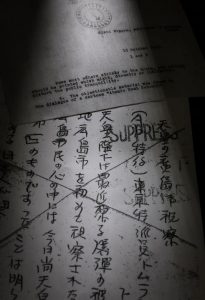Striving to fill voids in Hiroshima, Chugoku Shimbun and the press code — Articles about A-bombing in other newspapers, Part 2: Nishinippon Shimbun
Sep. 6, 2024
Three violation cases in articles involving atomic bombing and Emperor
In Nagasaki, the Nishinippon Shimbun, a regional newspaper based in Fukuoka City, had been published since before the war. In the company history for 1945 on the newspaper’s website is the statement, “While other local newspapers had evacuated outside of Nagasaki City, the Nishinippon Shimbun remained in the A-bombed city and continued its reporting. As a result, it became the number one newspaper in Nagasaki Prefecture.” At the same time, however, some of the paper’s reporters were killed in the atomic bombing while on the job.
Information about the Nishinippon Shimbun is included among the “unsorted” materials held in the Prange Collection, which includes materials regarding censorship by the General Headquarters of the Allied Powers (GHQ). Three articles were found to have been prohibited from publication for being in violation of the press code (reporting guidelines).
The first case of press-code violation was a cartoon. The censorship document for the cartoon pointed out that some parts of the conversation in the “Atomic Bomb Untruth,” which was to be published in the newspaper on October 15, 1945, had been in violation of the press code. The cartoon itself, however, was nowhere to be found, making details of the violation unclear. The Chugoku Shimbun inquired of the Nishinippon Shimbun about the matter, but their response was that they had no information because the cartoon had never been carried in the newspaper.
The second case involving a violation was an article in which an Associated Press (AP) correspondent in Tokyo had commented on the Emperor Showa’s first post-war visit to Hiroshima, in December 1947, immediately after the visit. The AP sent the article to the Nishinippon Shimbun and the Tokyo Shimbun, its partners on contract, as one of its partnership articles.
The article indicated that, “It is clear that the Emperor is still ‘number one’ in the hearts of citizens to this day,” touching on the reaction of Hiroshima’s citizens to the Emperor’s visit. The article also expressed the view that the emperor system would be maintained, mentioning, “The joy of the citizens of Hiroshima that the Emperor was with them completely offset their misfortune.”
Concern about success or failure of occupation
What part of the article was considered to be in violation of the press code? No censorship document stating the reason could be found.
Satoru Ubuki, a former professor at Hiroshima Jogakuin University who is engaged in the study of documents related to the atomic bombing, believes that, “Censorship staff might have been concerned about the success or failure of the occupation policy of democratizing Japan being in question.”
The third case of violation was an article reporting that “Uranium mine is discovered in Kyushu,” which was submitted on December 2, 1947, prior to publication. The English translation of the article was stamped with the word “SUPPRESS” (indicating that publication was prohibited). In this case, as well, no censorship document was found.
The discovery of the mine was made in a tunnel under Mt. Nagatare, which faces Hakata Bay in Fukuoka City. The article indicated that because the mineral mica, which had long been produced nearby, contained radioactive lithium, the Japanese Army had mined it for military purposes during the war. The article might have been deemed to contain information that could lead to the production of an atomic bomb.
Unpublished article
Meanwhile, one article was not published, although it is unknown whether it had been prohibited from publication. The article was a manuscript written by an American news agency that had been submitted on February 2, 1948, prior to publication. The article does not contain any indication of whether or not its publication was prohibited, and no censorship document remains. However, the possibility exists that the decision resulting from the censorship review process had affected whether the article was published.
The article introduced a former exchange student from Belgium who had studied at Kyoto University and been detained on the outskirts of Kobe City starting immediately after the attack on Pearl Habor in 1941 until September 1945. The article mentioned that after returning home, the student became a physician and a priest and was working on building a hospital and a church for the A-bombed Hiroshima.
This person in question was 33 at the time. I searched for related articles in the Chugoku Shimbun but was unable to find any. I inquired of Kyoto University about the name of the individual in the article but was told there were no documents proving the student’s enrollment at the university.
(Originally published on September 6, 2024)








